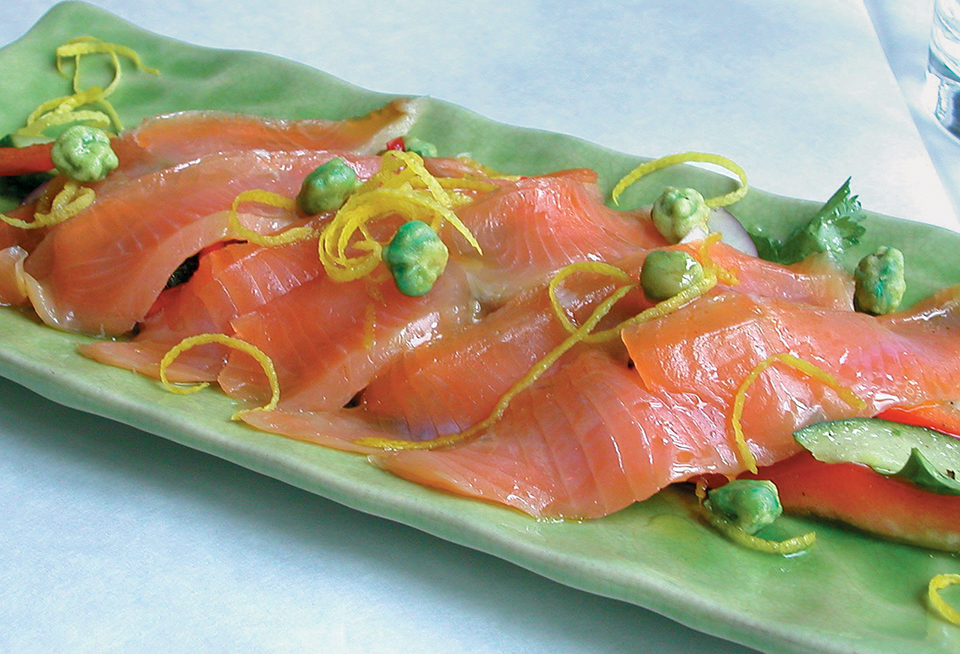Off-odors, flavors associated with spoilage due to microflora

Softer textures, fillet gaping, and liquid loss are serious problems for the smoking industry. Most sizes of farmed Atlantic salmon are now available throughout the year, but smokehouses may choose to freeze their fish before or after processing for reasons of tradition, price, or logistics. The product might also be frozen once or twice in the distribution system or by the consumer.
Freezing, frozen storage, and thawing are all processes that can cause changes in the properties of fish flesh and affect the quality of the product at consumption. The quality of cold-smoked Atlantic salmon is affected by freezing in various ways.
Before smoking, freezing results in increased product yield and water content, but also softer texture and increased freshness. Freezing also reduces the content of astaxanthin, but increases the lightness and color intensity of the flesh. When salmon are filleted and frozen before smoking, gaping increases. Freezing only after smoking leads to fewer changes in quality than freezing before smoking, and refreezing finished product has little additional affect on quality.
Fat effects
The distribution, total amount, and composition of fat in Atlantic salmon are all important quality parameters for salmon buyers. Fat has an important influence on the nutritional quality of the product, as well as the eating quality, which is assessed in terms of texture, flavor, and taste.
In a study of 120 salmon, trimming loss increased and smoking loss decreased as the fat content (140 to 230 grams/kg) and estimated fat deposits (6 to 14 percent) increased. As a result, neither the raw material fat content nor the estimated fat deposits have any effect on the total process yield with cold-smoked salmon.
Smoking loss is related to the gutted weight and dry-matter content of the fish. These two factors can explain the 52 percent variation in the smoking loss of brine-injected fillets. Weight explains 13 percent of the variation in total loss, with larger fish giving a higher process yield. Neither fat content nor fat deposits have been shown to significantly affect sensory properties.
Storage effects
Off-odors and flavors associated with cold-smoked salmon spoilage are due to the activity of microflora. In a study of the microbial and sensory changes in salmon stored for five weeks in vacuum packages at 6 degrees-C, the bacteria mainly responsible for spoilage were Lactobacillus sake, L. farciminis and Brohothrix thermosphacta. They produced sulfurous, acidic, and rancid off-odors, respectively.
Some strains of Serratia liquefaciens produced a rubbery, cheesy or acidic off-odor. Some Photobacterium phosphoreum isolates were characterized by an acidic effect.
The effects of packaging fresh Atlantic salmon under modified atmosphere with 60 percent carbon dioxide and 40 percent nitrogen, or air, and superchilling to minus-2 degrees-C or chilling to 4 degrees-C temperatures were also studied. The superchilled salmon packaged in modified atmosphere maintained good quality with negligible microbial growth for more than 24 days based on sensory and microbial analyses. Superchilled salmon in air had a 21-day sensory shelf life, whereas fillets in modified atmosphere or air stored under chilled conditions spoiled after 10 and seven days, respectively.
(Editor’s Note: This article was originally published in the February 2006 print edition of the Global Aquaculture Advocate.)
Now that you've finished reading the article ...
… we hope you’ll consider supporting our mission to document the evolution of the global aquaculture industry and share our vast network of contributors’ expansive knowledge every week.
By becoming a Global Seafood Alliance member, you’re ensuring that all of the pre-competitive work we do through member benefits, resources and events can continue. Individual membership costs just $50 a year. GSA individual and corporate members receive complimentary access to a series of GOAL virtual events beginning in April. Join now.
Not a GSA member? Join us.
Author
-

George J. Flick, Jr., Ph.D.
Food Science and Technology Department
Virginia Tech/Virginia Sea Grant (0418)
Blacksburg, Virginia 24061 USA[117,100,101,46,116,118,64,103,107,99,105,108,102]
Tagged With
Related Posts

Intelligence
A brief look at genetically modified salmon
If approved by FDA, fast-growing genetically modified salmon will provide a safe and nutritious product similar to other farmed Atlantic salmon.

Intelligence
A land grab for salmon (and shrimp) in upstate New York
The operators of Hudson Valley Fish Farm see their inland locale as a pilot to prove that land-based fish farming, located in close proximity to major metropolitan markets, can be successful.

Responsibility
A helping hand to lend: UK aquaculture seeks to broaden its horizons
Aquaculture is an essential contributor to the world food security challenge, and every stakeholder has a role to play in the sector’s evolution, delegates were told at the recent Aquaculture’s Global Outlook: Embracing Internationality seminar in Edinburgh, Scotland.

Responsibility
A look at integrated multi-trophic aquaculture
In integrated multi-trophic aquaculture, farmers combine the cultivation of fed species such as finfish or shrimp with extractive seaweeds, aquatic plants and shellfish and other invertebrates that recapture organic and inorganic particulate nutrients for their growth.

